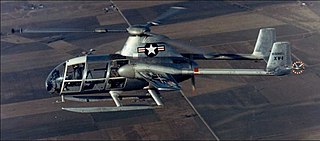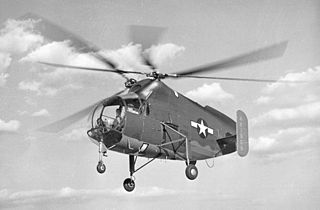Related Research Articles

The Kamov Ka-26 is a Soviet light utility helicopter with co-axial rotors.

The Hiller YH-32 Hornet was an American ultralight helicopter built by Hiller Aircraft in the early 1950s. It was a small and unique design because it was powered by two Hiller 8RJ2B ramjet engines mounted on the rotor blade tips which weigh 13 lb (5.9 kg) each and deliver an equivalent of 45 hp (34 kW) for a total of 90 hp (67 kW). Versions of the HJ-1 Hornet were built for the United States Army and the United States Navy in the early 1950s.

The Hughes XH-17 "Flying Crane" was the first helicopter project for the helicopter division of Hughes Aircraft Company. The XH-17, which had a two-bladed main rotor system with a diameter of 134 feet, still holds the world record for flying with the largest rotor system. It was capable of flying at a gross weight of more than 50,000 pounds (23,000 kg), but proved too inefficient and cumbersome to be mass-produced beyond the prototype unit.

The Sikorsky S-69 is an American experimental co-axial compound helicopter developed by Sikorsky Aircraft as the demonstrator of the Advancing Blade Concept (ABC) under United States Army and NASA funding.

The Fairey FB-1 Gyrodyne is an experimental British rotorcraft that used single lifting rotor and a tractor propeller mounted on the tip of the starboard stub wing to provide both propulsion and anti-torque reaction.
The Berger BX-110 was a prototype light helicopter built in Switzerland in the early 1970s. The single example was built by Hans Berger, a Swiss inventor and helicopter dealer. It was powered by a Wankel automotive engine and remained on the Swiss civil register until 1994. It was of conventional light helicopter configuration, with pilot and passenger sitting side by side under a large perspex bubble canopy, with the tail rotor carried on a tubular boom. The powerplant and fuel tanks were located behind the cabin, and the three-bladed main rotor had foldable blades. Landing gear was originally of skid type.

The NHI H-3 Kolibrie was a small helicopter developed in the Netherlands in the 1950s by Nederlandse Helikopter Industrie.

The McDonnell XV-1 is an experimental gyrodyne developed by McDonnell Aircraft for a joint research program between the United States Air Force and the United States Army to explore technologies to develop an aircraft that could take off and land like a helicopter but fly at faster airspeeds, similar to a conventional airplane. The XV-1 would reach a speed of 200 mph, faster than any previous rotorcraft, but the program was terminated due to the tip-jet noise and complexity of the technology which gave only a modest gain in performance.
The Fiat Model 7002 was a 1960s Italian general-purpose helicopter with a tip jet driven rotor built by Fiat Aviazione. Only one aircraft was built.
The Eagle Helicopter Eagle II and Eagle III were light helicopters developed in the United States in the early 1980s. With side-by-side seating for two, they had an unusual boxy fuselage shaped like a stubby wedge. No anti-torque system was required, since the rotors of both aircraft were powered by tip jets. In the case of the Eagle II, the tip jets were "cold", fed with compressed air generated by an Evinrude piston engine, while the Eagle III's rotor was driven by more conventional propane-burning jets. Development did not progress beyond the construction of a prototype in each configuration.

The Kellett XR-8 was a helicopter built in the United States during World War II. It was a two-seat machine intended to demonstrate the feasibility of a twin-rotor system, and while it accomplished this, it also demonstrated a number of problems that prevented further development of this particular design.

The Dornier Do 32E was a simple, collapsible one-man helicopter, designed for military use in Germany in the 1960s. Despite initial hopes of large orders and some proposed civilian roles, only three flew.
The Aero-Astra Okhotnik is a Russian single engine, three seat autogyro of pusher, pod and boom configuration. It has been developed into several variants from 2001 to 2007.
The American Sportscopter Ultrasport 254 is an American helicopter that was designed and produced by American Sportscopter and first flown in July 1993. The aircraft was produced by Light's American Sportscopter Inc from 1999. The aircraft was supplied as a kit for amateur construction.

The Sud-Ouest Ariel is a French two-seat light helicopter designed and built by Sud-Ouest. The helicopter rotors were driven by compressed-air jets at the end of each blade.

The SNCASE SE-3101 or Sud-Est SE-3101 was an early, experimental French helicopter with twin tail rotors. Only one was built.
The Air Command Commander 147A was an American autogyro that was designed and produced by Air Command International when it was located in Wylie, Texas. Now out of production, the aircraft was intended to be supplied as a kit for amateur construction.
The American Sportscopter Ultrasport 331 is an American helicopter that was designed and produced by American Sportscopter of Newport News, Virginia. Now out of production, when it was available the aircraft was supplied as a kit for amateur construction.
The Arrow Coax Livella Uno is a German helicopter under development by Arrow Coax Ultra Light Helicopter of Hornhausen and introduced at the AERO Friedrichshafen airshow in 2015. The aircraft is intended to be supplied as a kit for amateur construction.

The Youngcopter Neo (transl. New) is a German NOTAR helicopter that was designed by Björn Jung and is under development by his company, Youngcopter of Mainz. It was first publicly introduced at the ILA Berlin Air Show in 2008. The aircraft is intended to be supplied as a kit for amateur construction.
References
Notes
Bibliography
- Taylor, John W.R., ed. (1989). Jane's All the World's Aircraft 1989-90. London, United Kingdom: Jane's Yearbooks. ISBN 0-7106-0896-9.